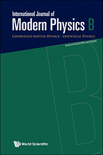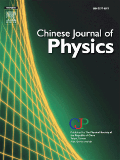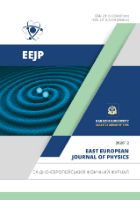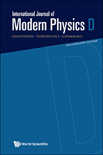
INTERNATIONAL JOURNAL OF MODERN PHYSICS B
Scope & Guideline
Unveiling the complexities of modern physics through peer-reviewed excellence.
Introduction
Aims and Scopes
- Nanotechnology and Nanomaterials:
Research on the synthesis, characterization, and applications of nanomaterials, including their electrical, optical, and mechanical properties. - Magnetohydrodynamics (MHD):
Exploration of fluid dynamics in the presence of magnetic fields, particularly in nanofluids and bio-convective systems. - Quantum Mechanics and Quantum Computing:
Studies related to quantum systems, quantum entanglement, and quantum computing applications, including the theoretical foundations and practical implementations. - Thermal and Energy Transport:
Investigation of heat transfer mechanisms, thermal properties of materials, and energy efficiency in various systems, including nanofluids. - Electromagnetic Properties and Applications:
Research on the electromagnetic behavior of materials, including photonic crystals, metamaterials, and their applications in sensor technologies. - Fluid Dynamics and Non-Newtonian Fluids:
Analysis of fluid flow behavior, particularly focusing on non-Newtonian fluids and their applications in industrial processes. - Computational Physics:
Application of numerical methods and simulations to solve complex physical problems across various disciplines.
Trending and Emerging
- Hybrid Nanofluids and Enhanced Heat Transfer:
There is a significant increase in research on hybrid nanofluids, focusing on their thermal performance and applications in heat transfer systems, showcasing the growing interest in improving energy efficiency. - Quantum Information and Computation:
Emerging studies in quantum information theory, including quantum entanglement and quantum computing technologies, reflect a growing trend towards understanding and harnessing quantum systems. - Bioconvection and Microbial Interactions:
Research exploring the effects of bioconvection, particularly in nanofluids and their applications in biological systems, is trending as it combines physics with biology, addressing real-world challenges. - Advanced Material Synthesis and Characterization:
An increasing focus on the synthesis of novel materials, including 2D materials and their heterostructures, is evident, driven by their potential applications in electronics and photonics. - Nonlinear Dynamics and Soliton Solutions:
There is a growing interest in nonlinear dynamics, particularly the study of soliton solutions in various physical models, indicating a robust exploration of complex systems. - Machine Learning Applications in Physics:
The integration of machine learning techniques in analyzing physical systems and materials characterization is gaining traction, showcasing the intersection of physics with data science.
Declining or Waning
- Traditional Superconductivity:
Research on conventional superconductors appears to be declining in favor of more advanced materials and mechanisms, such as high-Tc superconductors and unconventional superconductivity. - Classical Fluid Dynamics:
Studies focusing solely on classical fluid dynamics without modern advancements or applications to nanofluids are less frequent as the field shifts towards more complex, multi-phase systems. - Basic Material Characterization:
Basic characterization studies of materials without applications in advanced technologies or novel findings are becoming less common, as the emphasis shifts to practical applications and innovative materials. - Linear Optical Properties:
Research strictly on linear optical properties of materials is declining in favor of studies on nonlinear optics and their applications in modern photonic devices.
Similar Journals

JETP LETTERS
Bridging Tradition and Innovation in Scholarly ResearchJETP LETTERS, published by MAIK NAUKA/INTERPERIODICA/SPRINGER, is a prestigious journal in the field of physics and astronomy, which plays a pivotal role in disseminating groundbreaking research and innovative ideas since its inception in 1969. With an ISSN of 0021-3640 and an E-ISSN of 1090-6487, this journal aligns well with the interests of both seasoned researchers and emerging scholars, having achieved a 2023 category rank of Q3 for miscellaneous topics within physics and astronomy. Located in the United States at 233 SPRING ST, NEW YORK, NY 10013-1578, JETP LETTERS serves as a critical resource for its readership, offering exclusive insights and advancements across diverse areas of physics. While not open access, it hosts a collection of articles that refine theoretical approaches and experimental methods, providing both knowledge and inspiration to professionals and academics seeking to make impactful contributions to the scientific community. The journal’s quality is reflected in its Scopus ranking, where it stands at 39 out of 81 in the multidisciplinary category, placing it in the 52nd percentile, thus underscoring its significance and reliability as a scholarly outlet.

Science China-Physics Mechanics & Astronomy
Illuminating the Path to Scientific DiscoveryScience China-Physics Mechanics & Astronomy, published by SCIENCE PRESS, stands as a prestigious journal within the Physics and Astronomy domain, particularly recognized for its contributions to the understanding of fundamental and applied physics. With an exhilarating Q1 ranking in the 2023 category and earning a remarkable scopus rank of #21 out of 243, the journal demonstrates its significant impact, being positioned in the 91st percentile of its field. Operating under an Open Access model, it facilitates the broad dissemination of high-quality research, ensuring accessibility for researchers, professionals, and students worldwide. Its scope covers a variety of essential topics in physics and astronomy, promoting a comprehensive understanding of the latest advancements from 2010 through 2024. The journal is a vital resource for anyone aiming to stay at the forefront of research in these dynamic fields, with its prominent address located in Beijing, China, symbolizing its global influence.

CHINESE JOURNAL OF PHYSICS
Delivering High-Quality Research from Taiwan and BeyondCHINESE JOURNAL OF PHYSICS is a distinguished publication in the field of physics, published by Elsevier. With its roots in Taiwan, this journal has been a vital platform for disseminating innovative research findings since its convergence in 1996, and it continues to thrive, with articles contributing to the advancement of physics and astronomy until 2024. The journal is recognized for its high quality, achieving a notable Q2 ranking in the Physics and Astronomy category, positioning it among the top 30 out of 243 journals in its field, reflecting an impressive 87th percentile ranking. Although it does not operate under an open access model, the journal offers valuable insights into the latest trends and developments in general physics and astronomy, making it an essential resource for researchers, professionals, and students dedicated to advancing their knowledge and understanding of these dynamic fields. With a commitment to rigorous peer review and a diverse range of articles, the CHINESE JOURNAL OF PHYSICS is instrumental in fostering collaboration and innovation within the global scientific community.

Frontiers of Physics
Elevating Physics Knowledge to New HeightsFrontiers of Physics, published by Higher Education Press, is a premier open-access journal dedicated to fostering innovative research and excellence within the field of physics. With an ISSN of 2095-0462 and an E-ISSN of 2095-0470, this rapidly growing journal has established itself as a valuable platform for disseminating cutting-edge findings, covering a diverse range of topics from theoretical frameworks to experimental advancements. Notably, Frontiers of Physics has achieved an impressive Q1 ranking in the 2023 Scopus Quartiles for Physics and Astronomy, securing a competitive 5th out of 81 positions in its category, reflecting a high impact factor that underscores its importance to the scientific community. Since its inception in 2011 and continuing through 2024, the journal aims to bridge the gap between academia and industry, encouraging collaboration among researchers, professionals, and students alike. Its commitment to open access ensures that high-quality research is readily accessible, thereby promoting knowledge sharing and advancement in the global physics community. Explore the potential of your research in Frontiers of Physics, where the future of physics flourishes.

EUROPEAN PHYSICAL JOURNAL B
Driving Progress in Vital Areas of PhysicsEUROPEAN PHYSICAL JOURNAL B (ISSN: 1434-6028, E-ISSN: 1434-6036), published by Springer, is a prominent international journal based in Germany that focuses on the fields of Condensed Matter Physics and Electronic, Optical and Magnetic Materials. With a converged publication timeline from 1998 to 2024, it caters to a diverse audience that includes researchers, professionals, and students striving for the latest advancements in these vital areas of physics. The journal is recognized with a Q3 ranking in both relevant categories for 2023, showcasing its solid yet notable standing within the academic community. Although currently without an H-index, its Scopus rankings reflect a percentile performance of 41st and 39th, respectively, indicating a growing influence among its peers. The journal offers open access options, ensuring that groundbreaking research is widely accessible and contributes to the collective knowledge within the scientific domain. By aiming to publish high-quality, well-researched articles, the EUROPEAN PHYSICAL JOURNAL B plays a crucial role in disseminating innovative findings and fostering collaboration in the field of physics.

East European Journal of Physics
Pioneering research for a global readership.The East European Journal of Physics, published by the V N Karazin Kharkiv National University, is a dynamic open-access journal dedicated to advancing research in the fields of Physics and Materials Science. Since its inception in 2014, the journal has become a platform for scientists and academicians throughout Eastern Europe and beyond, fostering collaboration and dissemination of innovative studies and findings. With its ISSN 2312-4334 and E-ISSN 2312-4539, it attracts a global readership and submissions that are rigorously peer-reviewed to ensure the highest scholarly standards. Despite currently holding a Q4 category ranking in both Materials Science and Physics and Astronomy, as well as modest Scopus rankings, the journal is positioned to play a crucial role in elevating the visibility and impact of research emanating from this geographically and scientifically significant region through an open access model. This commitment to open scholarship is critical for fostering academic exchange and impact, making the East European Journal of Physics a valuable resource for researchers, professionals, and students seeking insight into the latest developments within these fields. Join us in exploring the frontiers of knowledge and innovation from Ukraine and its surrounding areas.

BRAZILIAN JOURNAL OF PHYSICS
Driving Progress in the Physics CommunityBRAZILIAN JOURNAL OF PHYSICS, published by SPRINGER, is a prominent platform dedicated to the dissemination of research within the realm of physics and astronomy. With an ISSN of 0103-9733 and E-ISSN of 1678-4448, this esteemed journal has been contributing to the field since its inception in 1996, and it continues to be pivotal in showcasing innovative studies and breakthroughs. The journal is categorized in the Q4 quartile for the year 2023, reflecting a dedicated focus on advancing knowledge across a variety of disciplines, particularly in general physics and astronomy, where it ranks 126th out of 243 in Scopus rankings. Although it currently does not operate under an open-access model, it remains an invaluable resource for researchers, professionals, and students eager to enhance their understanding of complex physical principles and developments. The journal is committed to promoting high-quality research, bridging gaps in knowledge, and fostering collaboration within the global physics community.

Journal of Contemporary Physics-Armenian Academy of Sciences
Advancing the Frontiers of Physics and Astronomy.Journal of Contemporary Physics-Armenian Academy of Sciences is a distinguished publication dedicated to advancing the field of Physics and Astronomy. Published by PLEIADES PUBLISHING INC, this journal features cutting-edge research that addresses contemporary issues and developments within the realm of physics. With an ISSN of 1068-3372 and an E-ISSN of 1934-9378, the journal enjoys recognition within the academic community, currently holding a Q3 category quartile ranking in 2023, indicating its relevance and contribution to general physics and astronomy. Although the journal is not open access, it provides valuable insights and a platform for scholars and researchers to share their findings, thus promoting collaboration and innovation in the field. Based in the United States, at PLEIADES HOUSE, 7 W 54 ST, NEW YORK, NY 10019, the Journal of Contemporary Physics serves as a vital resource for researchers, professionals, and students aiming to stay informed about the latest scientific advancements and theoretical explorations.

INTERNATIONAL JOURNAL OF MODERN PHYSICS D
Connecting Ideas in Space and Planetary ScienceWelcome to the INTERNATIONAL JOURNAL OF MODERN PHYSICS D, a premier publication dedicated to the advancement of knowledge in the fields of Astronomy and Astrophysics, Mathematical Physics, and Space and Planetary Science. Published by WORLD SCIENTIFIC PUBL CO PTE LTD in Singapore, the journal boasts an impressive impact, being ranked Q2 in Astronomy and Astrophysics and Mathematical Physics, and Q3 in Space and Planetary Science. With a converged publishing timeline from 1996 to 2024, this journal provides a vital platform for researchers and professionals to disseminate their findings, engage with cutting-edge research, and explore emerging ideas in modern physics. Although it operates under a traditional access model, the rigorous peer-reviewed process ensures that only the highest quality research contributes to the collective understanding of our universe. Join us in advancing the frontiers of physics and astronomy!

JOURNAL OF THE KOREAN PHYSICAL SOCIETY
Exploring New Horizons in Physics and AstronomyJOURNAL OF THE KOREAN PHYSICAL SOCIETY is a prominent academic journal dedicated to advancing the field of physics, published by the prestigious Korean Physical Society. With its extensive contribution to the scientific community since its inception in 1996, this journal serves as an essential platform for the dissemination of innovative research findings in various branches of physical science. Despite its current categorization in Q4 and a ranking reflecting its early-stage impact relative to peers, it remains a valuable resource for researchers, professionals, and students eager to explore developments in general physics and astronomy. The journal is accessible in both print and electronic formats, making it convenient for a global audience. Each issue aims to foster collaboration and knowledge-sharing within the field, ensuring that it remains relevant and instrumental in shaping future research directions. Located in South Korea, the journal continues to nurture a vibrant academic community, contributing to the ongoing dialogue in the global scientific arena.